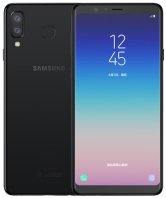
The Samsung Galaxy A8 Star delivered premium features in 2018 with its Gorilla Glass design, Super AMOLED display, and capable Snapdragon 660 chipset.
Introduction: Premium Design Meets Mid-Range Performance
Launched in June 2018, the Samsung Galaxy A8 Star (marketed as A9 Star in China) represented Samsung's ambitious push into the competitive mid-range segment. This device stood out with its premium glass and aluminum construction, high-resolution camera system, and vibrant Super AMOLED display, offering features typically found in more expensive flagship models at a more accessible price point of approximately €350.
Design & Display
The A8 Star featured a sophisticated design with Corning Gorilla Glass 5 protection on both the front and back, framed by durable aluminum edges. Measuring 162.4 x 77 x 7.6 mm and weighing 191g, it had a substantial, premium feel in hand. The 6.3-inch Super AMOLED display offered Full HD+ resolution (1080 × 2220 pixels) with an 18.5:9 aspect ratio, delivering vibrant colors, deep blacks, and excellent contrast. With a pixel density of 392 ppi and approximately 80.6% screen-to-body ratio, it provided an immersive viewing experience for multimedia content.
Performance & Hardware
At its core, the Galaxy A8 Star utilized the Qualcomm Snapdragon 660 chipset built on a 14nm process, featuring an octa-core CPU configuration with four performance cores clocked at 2.2 GHz and four efficiency cores at 1.8 GHz. This was paired with either 4GB or 6GB of LPDDR4X RAM, providing smooth performance for multitasking and gaming. The Adreno 512 GPU handled graphics-intensive tasks competently. Storage options included 64GB of eMMC 5.1 storage, expandable via microSD card for additional media storage.
Camera
Dual Rear Camera System
The camera setup was a highlight, featuring a dual-lens arrangement with a primary 24MP sensor (f/1.7 aperture) and secondary 16MP sensor (f/1.7 aperture). This combination enabled advanced photography features including portrait mode with bokeh effects, PDAF for fast focusing, and comprehensive shooting modes including HDR, panorama, and continuous shooting. The camera supported 4K video recording at 30fps, making it capable for both photography and videography.
Front-Facing Camera
The selfie camera featured a substantial 24MP sensor with f/2.0 aperture, capable of capturing detailed self-portraits and recording 1080p video at 30fps, appealing to content creators and social media users.
Battery & Charging
The device was powered by a 3,700mAh lithium-ion battery that provided all-day usage for most users. It supported 15W fast charging via USB-C, allowing for relatively quick recharge times. The combination of the efficient Snapdragon 660 processor and optimized software contributed to solid battery life performance.
Software & Features
The A8 Star launched with Android 8.0 Oreo with Samsung's Experience UI and received an upgrade to Android 9.0 Pie. It featured a comprehensive set of connectivity options including dual-band Wi-Fi 5 (802.11 a/b/g/n/ac), Bluetooth 5.0, NFC for contactless payments, and USB-C 2.0. Additional features included a rear-mounted fingerprint sensor, FM radio, and the increasingly rare 3.5mm headphone jack. The device supported dual nano-SIM cards with VoLTE capability and comprehensive 4G LTE bands for global connectivity.
Pros & Cons
- Pros:
- Premium glass and aluminum construction
- Excellent Super AMOLED display with minimal bezels
- Capable dual-camera system with 4K video recording
- Solid performance from Snapdragon 660 chipset
- Includes headphone jack and expandable storage
- Cons:
- eMMC storage slower than UFS standard
- No water or dust resistance rating
- Software no longer receiving updates
- Relatively heavy compared to contemporaries
Tags: Samsung, Galaxy A8 Star, Android, smartphone, review, camera, specs, performance
The Samsung Galaxy A8 Star delivered premium features in 2018 with its Gorilla Glass design, Super AMOLED display, and capable Snapdragon 660 chipset.

Post a Comment